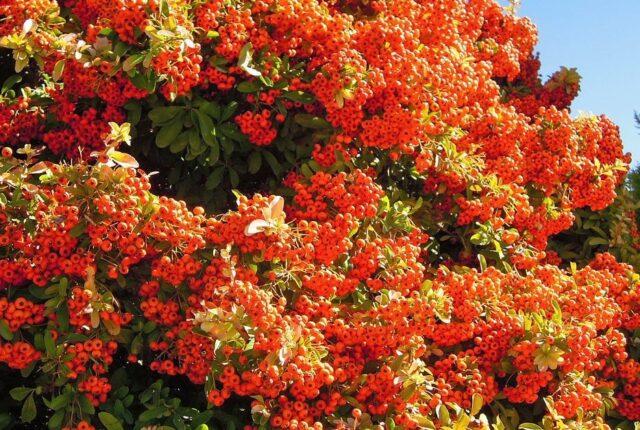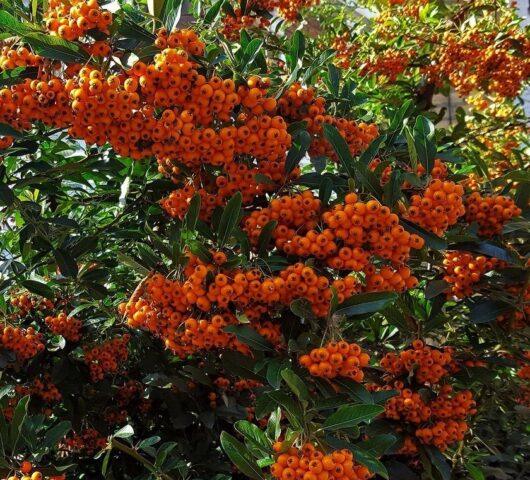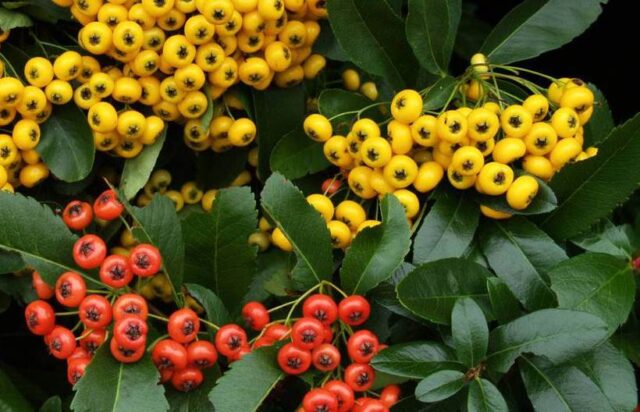Content
Pyracantha is an evergreen ornamental shrub belonging to the Rosaceae family, subfamily Spiraea. The plant is not highly resistant to frost; only a few hybrid varieties can withstand temperatures dropping to -20 ᵒC.
Description of Pyracantha
The name of the ornamental shrub is derived from Greek words, which are translated into Russian as “thorn” and “fire”.
The pyracantha plant is a shrub with erect or spreading branches. The height of the crop reaches 6 m. The stems of the pyracantha bush (pictured) are studded with sharp thorns up to 2.5 cm long. The leaves of the bush are dark green, have an elliptical shape, and have jagged edges.

After ripening, the fruits become yellow or bright red in color.
The plant was classified as a subspecies of Appleaceae, so its berries are considered to be small apples.
When does pyracantha bloom?
The pyracantha shrub attracts attention with its abundant flowering. The flowers are white-cream in color, collected in corymbose inflorescences. The plant blooms in May and blooms until mid-summer. The flowers exude a pleasant aroma and are honey plants.
Are pyracantha fruits edible?
The fruits are not poisonous, pyracantha berries can be eaten, but because of the bitterness, people do not eat them. Birds feed on the fruits of this ornamental shrub.

The berries remain on the bushes until spring
Types and varieties of pyracantha
Two species of pyracantha are cultivated in European Russia. This is a bright red and narrow-leaved variety. They are popular with gardeners and landscape designers.
Pyracantha bright red
The bright red pyracantha came to Russian latitudes from Asia Minor and southern Europe.

Widely spreading bush grows up to 2 m in height
The leaves are oblong-elliptical in shape, up to 4 cm long. In summer and spring, the leaf blades are colored juicy green, turning red in winter. The fruits are spherical in shape and grow up to 6 cm in diameter.
The most popular varieties of bright red pyracantha are Red Cashme and Red Column.
Pyracantha angustifolia

The narrow-leaved plant is native to Southwest China.
The genus is highly resistant to frost. The shrub grows up to 4 m, the leaves reach 5 cm in length. Pubescence is observed on young leaves. The fruits are slightly flattened, painted in bright orange tones. The berries of this type of pyracantha are quite edible.
The most popular varieties of angustifolia pyracantha are Golden Charmer and Orange Glow.
Planting pyracantha in open ground
Pyracantha is not demanding on the composition of the soil.When choosing a planting site, you should remember that in lowlands where water stands for a long time in the spring, ornamental shrubs may die. It is recommended to plant the plant on southern slopes, but so that it remains in partial shade. Under the burning sun, the leaf blades acquire a yellow tint.
When to plant
When growing shrubs from seeds, sowing in open ground is carried out in the spring. Before this, the planting material must be stratified (1.5-2 months before planting, the seeds are placed in the refrigerator, on a shelf for storing vegetables).
It is not recommended to carry out the procedure in the fall, since before the onset of winter the pyracantha will not have time to take root and will die.
Planting scheme

If an ornamental shrub is planted to create a hedge, the distance between seedlings is maintained within 60-100 cm
Although the plant is unpretentious to the composition of the soil, the area for planting is prepared in advance. Within a week, it is dug up to a depth of 35-40 cm, having previously distributed the humus. The amount of fertilizer is calculated according to the scheme - 5-8 kg per 1 m2. After digging, the soil in the garden bed is leveled.
Planting pyracantha in open ground:
- A drainage layer is installed at the bottom of the pit using coarse sand or fine gravel.
- A stake is driven into the middle of the pit, which after planting the plant should rise 0.5 m above the surface.
- Soil mixed with humus is poured around the support.
- Before removing the plant from the container, water it thoroughly.
- Carefully transfer the seedling into the hole and carefully straighten the roots.The soil is poured into the pit in layers, lightly compacting it.
- A trench is made around the planted shrub. 10-15 liters of water are poured under 1 seedling.
When the liquid is absorbed, the pyracantha is tied to a support, and the tree trunk circle is mulched.
Caring for pyracantha in open ground
Caring for ornamental shrubs comes down to timely watering and loosening the soil. Don't forget about pruning and fertilizing.
Watering
Pyracantha is a drought-resistant crop, so there is no need for systematic watering. For newly planted seedlings, a schedule should be followed. Such plants need weekly watering. An indicator that pyracantha is not getting enough moisture are leaves that wither and shoots that acquire a yellow tint.
To prevent water from spreading over the surface of the soil, it is poured into the tree trunk circle. After a day, the soil around the bush is loosened and the weeds are removed.
Top dressing
The culture does not need frequent feeding. During the growing season, it is enough to fertilize the bush twice. For the first time in the spring, during a period of intensive growth. The second feeding is applied at the end of summer. A mineral complex fertilizer with a minimum nitrogen content should be used.
Transfer
You can replant pyracanthus according to the same scheme as the purchased seedling. It should be remembered that the bush does not like to be moved from place to place.

In order for the plant to take root better, after replanting it needs to be provided with regular and abundant watering.
Pruning pyracantha
Pruning of pyracantha can be done at any time of the year, but experts recommend following this scheme:
- The first pruning is carried out after the bush has faded. It should be remembered that berries are formed only on stems that are more than one year old.
- The second pruning is carried out in mid-October. This time, the shoots that thicken the plant are cut out. Also, branches that shade the fruits, causing them to begin to rot, must be removed.
- The third pruning is carried out at the end of November - beginning of December. Remove all excess stems and leaves.
When carrying out the rejuvenating procedure, the plant is shortened to 0.3 m. Since the bush is strewn with thorns, the procedure should be performed with gloves.
Wintering
Some types of ornamental shrubs tolerate frost well. For example, the winter hardiness of narrow-leaved pyracantha in the Moscow region is quite high; the plant does not need shelter. It is enough to sprinkle the tree trunk circle with a thick layer of fallen leaves. During frosts below -20ᵒC, if there is no snow cover, some of its shoots freeze, but with the arrival of spring they quickly recover.
How to propagate pyracantha
Ornamental shrubs can be propagated by generative or vegetative methods.
Most often, the crop is propagated by cuttings or layering. In this case, the seedling will retain the varietal qualities of the mother plant. Both woody and green cuttings are suitable for propagation. You can use branches removed during spring pruning. To obtain a cutting, a shoot 15-20 cm long is suitable.
How to get a pyracantha seedling:
- All leaves are removed from the bottom of the cutting and immersed in a solution of a root growth stimulator.
- The treated shoots are placed in damp sand at an angle.
- The top of the container is covered with a transparent cap.
- The cover is removed daily to ventilate the seedling and prevent rotting of the root system.
After three weeks, the cutting will take root, but it can only be replanted in a permanent place after a year.

If the seedlings are intended for planting as a hedge, they are grown in greenhouse conditions for two years
An easier way to propagate the pyracantha population is to obtain cuttings. To do this, strong, low-growing branches are selected in the spring. They are bent to the ground and sprinkled with soil in several places. Throughout the summer, the cuttings should be watered regularly and the soil next to them should be loosened. For the winter they are sprinkled with dry leaves, and in the spring they are separated from the mother bush and replanted.
Diseases and pests
Pyracantha has good immunity and is rarely affected by diseases and pests. The greatest threat to the shrub is aphids, which settle on the plant if it is weakened. When an insect is detected, the bush is treated with insecticides, since aphids multiply too quickly and can spread to neighboring plants.
If agricultural standards are violated, the crop is affected by scab or late blight. To combat them, use a solution of Fundazol or another fungicide. Sometimes an ornamental shrub is affected by bacterial burn, but the disease cannot be treated. Experts recommend choosing varieties that are immune to this disease.
Photo of pyracantha in landscape design
Thanks to its lush and long-lasting flowering, pyracantha is quite popular among gardeners who decorate their backyards with shrubs.

A shrub can become a bright accent of a flower bed

Pyracantha seedlings are used to form hedges
The foliage and berries will delight the eye throughout the winter, and the thorns on the shoots will not let uninvited guests through.

Pyracantha looks impressive in single plantings
The plant is used to decorate unsightly walls and fences.

Pyracantha can also be grown indoors. It looks beautiful as a small tree with one or two trunks.
Conclusion
Pyracantha is an unpretentious ornamental shrub. It doesn’t matter to the plant what kind of soil it grows on, the main thing is that it is protected from drafts. The branches of the crop have large sharp thorns, so care should be carried out with thick gloves.
Reviews about growing pyracantha








